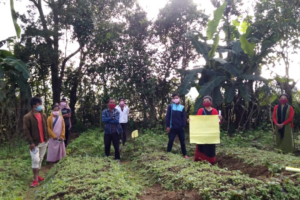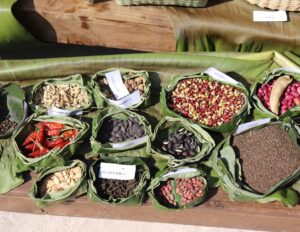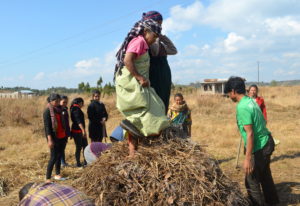Originally published in The Shillong Times
Article by H H Mohrmen
A decade or two ago, countries, churches and all kinds of organisations worth their name were busy planning vision 2020 for their organisation. Perhaps like the year 2000, the year 2020 too has its own charm which made these organisations spend valuable resources both time and money to come up with a vision or a plan in the name of the year, but look where we are now. Three months into the year everything goes haywire, all the calendars and year planners have become useless. No one ever expected that three months into the year, they would be compelled to throw out of the window all that they have meticulously planned for the year and beyond.
Not only all the efforts which went into designing the vision went down the drain, but the pandemic which is happening this year is definitely going to usher in a new beginning for the country, the state and the society. Experts on the subject are of the opinion that till a cure for the ailment is found or till a vaccination is discovered life is not going to be as usual again. The new normal is going to reign supreme the world over. The new way of life will include people having to add few more items to list of things that they carry with them on a daily basis. The mobile phone, wallet and watch is not going to be the only item that people have to carry as imperatives. To the list must be added a mask and a bottle of hand sanitizer every time one decides to go out of the house.
At the personal hygiene level apart from regular washing of one’s hands, one will also have to maintain physical distancing which is going to be another new normal in times to come. Therefore travelling on public vehicles or sharing a taxi will not be the same again. But the objective of this write-up is to look at the economic impact of the lockdown at the local level by learning from the experiences during the lockdown period. The few lessons that one has learned is from the experience of trying to help the farmers move and market their produce during the lockdown period.
The lockdown resulting from Covid- 19, has initially taken the farmers by surprise and hit them very hard because they were not able to sell their produce in the markets as usual. The Society for Urban and Rural Empowerment (SURE), Jaiñtia hills in collaboration with a local online platform came to the rescue and helped bridge this gap by becoming a liaison between farmers and the online platform. And from March 28 the partnership help started home delivery of essential goods in Jowai town and some rural area. The products were mainly local vegetables and local meats like local pork, local chicken and local fruit which were produced by the Self Help Groups and the farmers promoted and supported by the NGO mostly from Thadlaskein and Laskein blocks of West Jaiñtia hills. The effort would not have been possible without the help and support of West Jaintia hills 1917 iteam vehicle which charges only Rs. 2.3 paisa per kg for transporting the farmers’ produce from their villages to Jowai.
This small effort enabled the otherwise distressed farmers to sell their produce during this difficult time when both the state and the country are being affected by the corona virus lockdown. In Jowai town the online platform Syllad.com helped provide home delivery of vegetables, fruits and meat at the doorstep of the people of the town. Later when the markets at the respective localities were opened, in coordination with the different headman in the town the organisation was able to sell the farmer’s produce in different localities. This was being done with the support of the District Administration of West Jaiñtia Hills and the community leaders. This effort has not only helped farmers sell their produce but more importantly it helped the people of the town to follow government guidelines and stay at home during the lockdown period.
Lesson number one that the pandemic has taught is the importance of locally produced food especially fruits and vegetables in catering to the urgent needs of the people. Initially the lockdown had closed all the entry and exit points to the state and the respective districts, restricting entry of items like vegetables etc., so the only option was to rely on locally produced vegetables and fruits. With regard to fruits, the only ones that are produced locally are the indigenous fruits like sohshang and sohphie which are available in abundance.
It was also learned that though farmers in West Jaiñtia hills did produce vegetables but they were not sufficient to cater even to the needs of citizens of the district. Fortunately the shortage of vegetables coming from outside compelled the people to go back to eating their indigenous foods which are mostly wild edibles. Perhaps it is not wrong to say that at least in West Jaiñtia hills, consumption of indigenous vegetables had gained popularity during the period and even those who have never tried some wild vegetables have shown interest and started asking for recipes on how dishes from the same can be prepared.
Indigenous vegetables which would otherwise not even find a place in the weekly market earlier have started appearing in the market. Lapawi the tip of a fern plant, ka Palong or spinach, Latdoh, Lachieiñ which is purple flower, Soh salachiat, Khliang syiar or Tyngkhieh, Chkor blang, Sla lachiat, Jatira, ka Wang, Pachor khian, Pachor heh, Jamyrdoh, ka Jri, Ïajaw, Ïamyrdoh are some of the wild vegetables which are now becoming popular.
If the pandemic has anything to teach the people in this regard, it is the need to develop local agriculture. COVID-19 pandemic also reminds us that the district is not only in short supply of rice but it is not even able to produce enough vegetables for the district’s own consumption. Post the COVID-19 lockdown the government needs to immediately put more effort in helping the farmers to produce more vegetables. If West Jaintia hills district is taken as an example, the lockdown has also brought to light the fact that the district has not been able to produce enough meat too. The district still needs to improve meat production to cater to local consumption.
Perhaps the Indigenous food system is one area which has been neglected by the government; it is the sector which no government has never even considered important before. It was never on the radar screen of the government and the lockdown has educated us of the need to seriously look at the indigenous food systems that are available in the state. It may also be mentioned that the IFS are micro nutrient-rich species and they are endemic to the area and each region of the state have their own variety of indigenous food system specific to the area.
Another idea worth exploring that indigenous fruits are all seasonable so simple processing like making of pickle, dry and even fermenting the fruits would help preserve the same. It is adding value to the produce so this can be an economic activity, in which an enterprise can start up. People already have tradition of preserving fishes by way of smoking and drying fish; new ideas can be explored to preserve wild and indigenous fruits in the future.
The lockdown not only justifies the need for strengthening the rural economy to develop the economy at the local level, but this will also make the state’s economy stronger. More importantly this will also lead to food sovereignty. Self-sufficiency in food production should be the number one priority of the state government because this will lead to food sovereignty when farmers will be in control of their produce. We need to strive hard for self sufficiency in food, vegetables, fruits meat and fishes production as this will also help strengthening local economy in the rural areas. Development for small states like Meghalaya where majority of the population lives in the rural areas, depend largely on the strength of for its rural economy.




We must thank the writer, Mr Mohrmen, who has done a wonderful job penning his observations regarding the scale of the Pandemic’s reach and its permanent impact on everything and everywhere.
The world as we know it is gone forever and the new normal has come to stay. However sad the situation, we all have only one choice: deal with it. What’s heartening, however, is aptly highlighted by the writer: people are beginning to rediscover local foods, many of them long lost and long forgotten precious gifts of nature. Another positive trend is that Organisations, NGOs and SHGs like the ones the author showed as examples are coming to the fore with new initiatives that can only make life easier for everyone. They are actuallytaking the bull by the horns, rising to the occasion. Because the pandemic leaves no room for us to appeal!
This reminds me of the days when we didn’t know food from the plains. We had our own local produce – from rice to meats to vegetables to fruits. They were all natural, unadulterated, and grown with indigenous know-how. Their taste was premium too. Did we have problems then? No!
It seems to have come back to that now. If that be so, and local food is the new norm, then we can say the virus sweep is a blessing in disguise! We’d better gear ourselves and embrace this new opportunity of growing our own food locally. Besides, we can do better now because of technology.
The pandemic isn’t so bad after all, if we take it in that spirit! And the government will do well to take cognizance of this too.
Thank you, Bah Mohrmen for your eye-opening write-up!